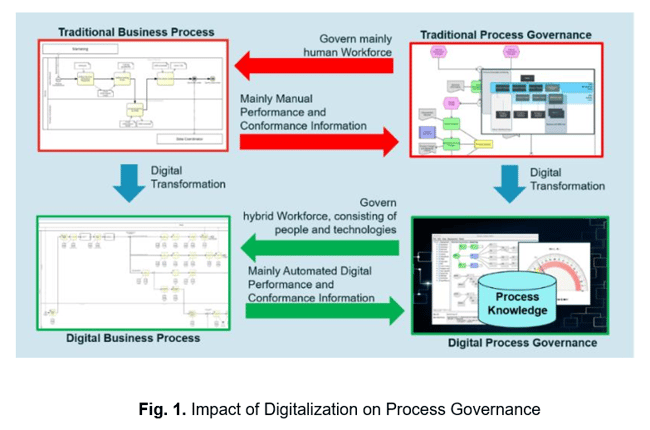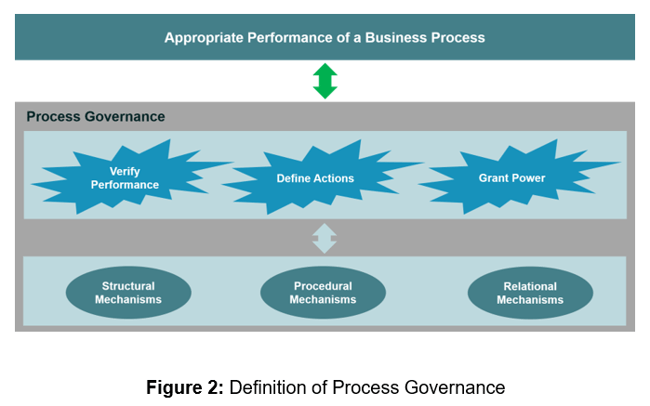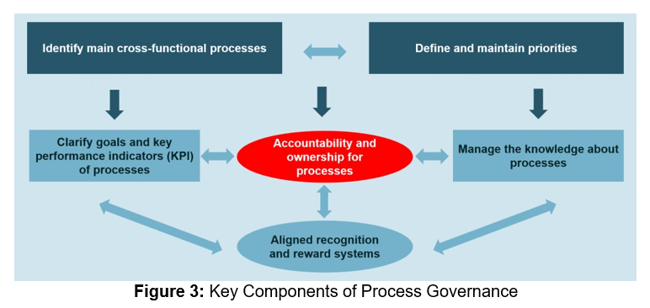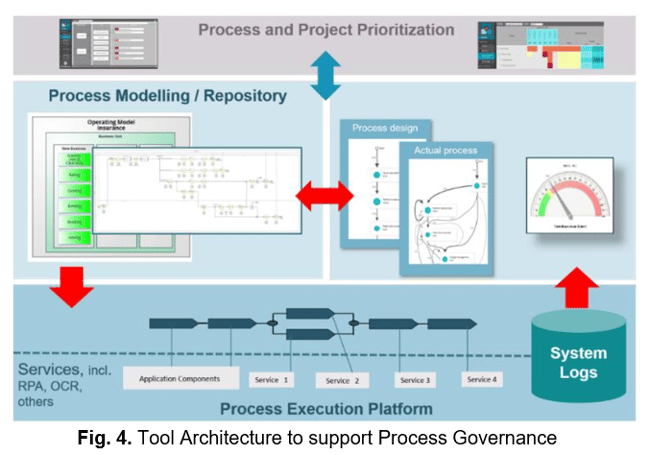










































-1.png?width=300&name=BLOGS%20COMPANY%20LOGO%20(58)-1.png)

Digitalization of Business Process Governance
The Impact of Digitalization on Process Governance
Most companies in the middle of digital transformation initiatives or at least plan for them (Kirchmer, Franz, Lotterer, Antonucci, Laengle, 2016). Hyper-Automation has become a reality which changes the way business processes are organized and executed (Stoudt-Hansen, et al., 2019). However, only a small number of organizations have their business processes sufficiently under control to realize the full potential of new digital technologies (Kirchmer, 2019) (Cantara, 2015). Appropriate business process management (BPM) capabilities have a significant impact on the value achieved through digitalization (Antonucci, et al., 2020).
This is especially true for establishing appropriate business process governance. Process governance drives the realization of the targeted digitalization benefits as well as the ongoing improvement and change of digital processes (Kirchmer, 2015) (Rosemann, 2015) (Hove, Rosing, Storms, 2015) (Franz, Kirchmer, 2012). Process governance identifies necessary adjustments of the process, defines the required actions and ensures their execution. In a digital environment where an increasing number of applications is housed in the cloud, processes, hence the way how to use the digital tools, have become a key asset of an enterprise (Kirchmer, 2017) (Abolhassan, 2016), that must be managed properly.
Digital processes require a new governance approach to realize their potential. Speed, flexibility, and effectiveness must be combined. The new process governance leverages the opportunities of digitalization systematically.
Technologies supporting a digital business process deliver data about a process that has not or not fast enough been available with traditional business processes. This includes data about the performance of a process as well as about its compliance with the process design and related compliance requirements. Process governance uses this data to increase its effectiveness.
The ongoing adjustment and re-configuration of digital technologies can often be done by business departments, with limited or no support of the information technology (IT) organization. Process governance must reflect this new business reality.
As consequence, process governance must go through a digital transformation itself, leveraging appropriate tools, such as process mining (van der Aalst, 2016) or dynamic process modelling and simulation (Scheer, 1998), to meet those needs of a digital environment. The result is digital process governance which is value-driven, tool-enabled and people-centric.
The impact of digital transformation on process governance is visualized in Fig1.
 Definition of business process governance
Definition of business process governance
Business process governance is the organizational framework to establish and maintain end-to-end process performance in an organization. It exists in parallel to the structural, often function-oriented, organization with its reporting lines. Process governance manages the alignment of different activities with the requirements of internal and external clients.
Governance in general relates to processes and decisions that seek to verify performance, define actions, and grant power (Wikipedia, 2020). This definition can be transferred to business process governance: Process Governance relates to processes and decisions that seek to verify performance, define actions, and grant power related to the management of operational processes through the “process of process management” (Kirchmer, 2017) (Hove, Rosing, Storms, 2015) (Rosemann, 2015). Process governance does not replace the existing organization structure. It adds an additional market and customer-focused view to ensure appropriate business process performance (Spanyi, 2015.
The application of process governance must be defined in the context of a specific organization. It is delivered through a combination of different mechanisms (Janssen, 2015):
The definition of process governance is visualized in Figure 2.
 Process governance addresses the entire lifecycle of a business process. Its key focus is on the running process. All process components, as described in the ARIS architecture, are relevant for the governance approach: organization, functions, data, deliverables, and control flow, as well as the technology support of process execution (Scheer, 1998). This leads to a close relation between process governance and other governance approaches, such as IT governance or data governance. The alignment with those related governance organizations needs to be reflected in the process governance approach.
Process governance addresses the entire lifecycle of a business process. Its key focus is on the running process. All process components, as described in the ARIS architecture, are relevant for the governance approach: organization, functions, data, deliverables, and control flow, as well as the technology support of process execution (Scheer, 1998). This leads to a close relation between process governance and other governance approaches, such as IT governance or data governance. The alignment with those related governance organizations needs to be reflected in the process governance approach.
Key components of business process governance
This definition of process governance is operationalized to establish it in an organization. It is realized through six key components (Kirchmer, 2017):
To govern business processes, those processes need to be identified, from the external event that starts them until the result of value they deliver. The goals of those processes must be defined clearly as basis to measure and verify the process performance. Key performance indicators (KPI) operationalize those goals. Accountabilities and ownership, combined with appropriate empowerment and direction, enable necessary performance improvements. This is the core structural component of a process governance approach which reflects the people-centricity. It also includes the definition of the relation to other governance bodies. To enable fast decisions and the definition of required actions, the right degree of transparency over processes and their behavior is required. This is achieved though the management of knowledge about a process and the way it is executed. Recognition and reward systems must be aligned with the defined ownership roles and accountabilities to provide the right motivation. A company only competes through 15-20% of its business processes (Franz, Kirchmer, 2012). These high impact processes must be in the focus of process management and improvement initiatives. Hence, appropriate priorities for the use of resources must be set and applied.
The key components of process governance are summarized in Figure 3.
 Enhancement opportunities for process governance through digitalization
Enhancement opportunities for process governance through digitalization
The possible improvement of process governance through digitalization is examined using the six key components of process governance. These governance components are impacted in two ways through a digital transformation:
The identification of the key business processes is not directly impacted though the digitalization. However, leveraging process reference models, leveraging a repository tool, simplifs this activity (Kirchmer, Franz, 2020) (Kirchmer, 2017). The reference models can be used as guideline to identify the company specific core processes and describe those on a high level. Having those process models available in a digital formal also enables the ongoing adjustment of the process scope. Process mining tools may also help identifying processes, if they are already sufficiently automated.
The goals of processes and related KPIs are defined based on the overall business strategy of the organization. Digital process and project prioritization tools help to break down strategic imperatives into value-drivers and to assess the impact of subprocesses on those value-drivers. Process KPIs describe the relation of sub-process to value-drivers. Digital tools support the definition of the most relevant of KPIs. The availability of performance data about digital processes helps to establish the baseline for KPIs and set realistic improvement targets. Process mining tools extract this information.
The definition of ownership and accountabilities, remains the key aspect of process governance. This reflects the people-centricity of the governance. Digital transformation does not change this organizational activity itself. However, it simplifies its realization and day-to-day application. The availability and easy access to relevant governance information allows to streamline the structure of the governance organization. This is the same effect information technology has on the organizational structure of a company where middle management positions can be cut out since their role to aggregate data is no longer required (Hammer, Champy, 1993). Having comprehensive and accurate information about the process, delivered through process repositories and mining tools, speeds up decision making and increases the acceptance of those decisions. The collaboration between different people involved in process governance can be supported through digital collaboration and workflow tools which increases those effects even further.
Basis for all process governance activities is the availability and management of the required knowledge about the process. This governance component is significantly improved in a digital environment. The availability of performance and conformance information though process mining applications used by the governance organization allows fast-well informed decisions and focused actions (Scheer, 2018) (Van der Aalst, 2016). Structural information about the process, captured in process modelling and repository tools (Kirchmer, Franz, 2020a) (Kirchmer, 2017) (Scheer, 1998), is important to create a baseline and manage the process conformance. The use of process reference models across business units simplifies the governance of process standardization.
Recognition and reward systems reflect the achievement of end-to-end performance goals of a business process. This is in general independent of the digital process transformation. However, the simpler and more reliable measurement of KPIs through tools like process mining improves this governance component.
High impact low maturity processes are the best targets for optimization and innovation initiatives - independent of the degree of digitalizing (Franz, Kirchmer, 2012). Process governance priorities need to reflect this and evaluate initiatives based on their effect on those high impact processes. Digital tools supporting a process and project impact assessment as well as the resulting prioritization enhance this governance component (Kirchmer, Franz, 2020b). Process mining tools deliver the required information about actual processes.
An architecture of tools to support digital process governance is shown in Fig. 4.
 Establishing digital process governance improves the overall performance of the BPM-Discipline and its role in strategy execution. This leads to an improved process lifecycle management and with that the systematic transfer of strategy into technology and people-based execution, at pace with certainty (Kirchmer, 2015).
Establishing digital process governance improves the overall performance of the BPM-Discipline and its role in strategy execution. This leads to an improved process lifecycle management and with that the systematic transfer of strategy into technology and people-based execution, at pace with certainty (Kirchmer, 2015).

View our schedule of industry leading free to attend virtual conferences. Each a premier gathering of industry thought leaders and experts sharing key solutions to current challenges.
View Schedule of EventsWelcome to BTOES Insights, the content portal for Business Transformation & Operational Excellence opinions, reports & news.
-------------------------------------------------------
Search for anything
Insights from the most progressive thought leaders delivered to your inbox.
Insights from the world's foremost thought leaders delivered to your inbox.
Being a hero is all about creating value for others. Please invite up to 5 people in your network to attend this premier virtual conference, and they will receive an invitation to attend.
If it’s easier for you, please enter your email address below, and click the button, and we will send you the invitation email that you can forward to relevant people in your network.
View our schedule of industry leading free to attend virtual conferences. Each a premier gathering of industry thought leaders and experts sharing key solutions to current challenges.
View Schedule of EventsWatch On-Demand Recording - Access all sessions from progressive thought leaders free of charge from our industry leading virtual conferences.
Watch On-Demand Recordings For FreeDelivered by the industry's most progressive thought leaders from the world's top brands. Start learning today!
View All Courses NowThe premier Business Transformation & Operational Excellence Conference. Watch sessions on-demand for free. Use code: BFH1120
Watch On-DemandInsights from the most progressive thought leaders delivered to your inbox.
Insights from the world's foremost thought leaders delivered to your inbox.
Being a hero is all about creating value for others. Please invite up to 5 people in your network to also access our newsletter. They will receive an invitation and an option to subscribe.
If it’s easier for you, please enter your email address below, and click the button, and we will send you the invitation email that you can forward to relevant people in your network.
Courtesy of Nintex Pty's Paul Hsu, below is a transcript of his speaking session on 'Improve employee productivity during and post-COVID by ...
Read this article about HP, Best Achievement in Operational Excellence to deliver Digital Transformation, selected by the independent judging panel, ...
Read this article about BMO Financial Group, one of our finalists, in the category Best Achievement in Operational Excellence to deliver Digital ...
Read this article about Cisco, one of our finalists, in the category Best Achievement of Operational Excellence in Internet, Education, Media & ...









































































































































































































